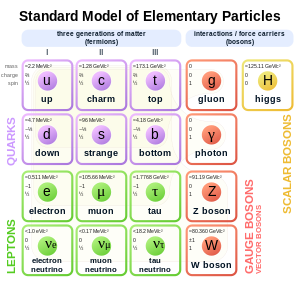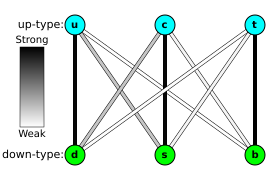쿼크 (quark)는 소립자 바리온과 메존을 이루는 기본입자이다.
| 이름(영문) | 기호 | 전하량 | 질량 (MeV) |
|---|---|---|---|
| 업,위(Up) | u | +2/3 | 1.5 - 5 |
| 다운,아래(Down) | d | -1/3 | 17 - 25 |
| 참,맵시(Charm) | c | +2/3 | 1100 - 1400 |
| 스트레인지,야릇한(Strange) | s | -1/3 | 60 - 170 |
| 톱,꼭대기(Top) | t | +2/3 | 165000 - 180000 |
| 보텀,바닥(Bottom) | b | -1/3 | 4100 - 4400 |
각 쿼크에는 해당하는 반쿼크라 불리는 반입자(antiparticle)가 존재하며, 전하량이 반대이다.
각 쿼크 알갱이는 기본 전하의 1/3 혹은 2/3에 해당하는 전하량을 갖는다. 양자색역학(QCD)에 따르면, 쿼크는 홀로 존재할 수 없고 언제나 (쿼크와 반쿼크 쌍의) 메존, 혹은 (세 개의 쿼크, 혹은 세 개의 반쿼크의) 바리온의 형태로 존재하여, 언제나 기본 전하량의 정수배만이 검출된다.
전하량 외에도 쿼크는 색전하(色電荷)란 물리량을 갖는데, 이 양은 '빨강', '초록', 혹은 '파랑'으로 나타낸다. 이 물리량에 대한 보존법칙은 합쳐진 입자는 언제나 '무색'이어야 한다고 말한다. 반쿼크는 '반빨강', '반초록', '반파랑'의 색전하를 갖는다.
이 보존법칙에 따라 쿼크는 홀로 관측될 수 없고, 다른 쿼크, 혹은 강한 상호작용 입자와 합쳐진 상태로만 관측된다. 따라서 위에 적힌 쿼크의 질량은 정확한 값이 아니라 참값이 놓여 있을 것으로 여겨지는 범위만을 말하고 있다.

up quark 2개 과 down quark 1개 로 구성된 photon
Quark
elementary particle and constituent of matter.
combine to form composite particle called hadrons.
most stable hadrons are: protons and neutrons.
quarks have never been directly observed in isolation. they have been found within hadrons or mesons.
six types of quarks: up, down, strange, charm, bottom and top.
up and down quarks: have lowest mass of all quarks.
heavier quarks rapidly change into up and down quarks via particle decay: transformation from higher mass state to lower mass state. thus up and down quarks are most common in the universe. strange, charm, top and bottom quarks are only produced in high energy collisions.
quarks have intrinsic properties: electric charge, color charge, spin, and mass.
quarks are the only elementary particles in Standard Model of pharticle physics to experience all four fundamental interactions (also known as fundamental forces: electromagnetism, gravitation, strong interaction, and weak interaction).
also only known particle whose electrical charges are not integer multiples of the elementary charge.
for every quark flavor there is a corresponding type of antiparticle: antiquark.
antiquark: some of its properties have equal magnitude but opposite sign.

six of the particles in the Standard Model are quarks (purple). Each of first three columsns form a generation of matter.
Standard Model: theoretical framework describing currently known elementary particles and Higgs boson.
6 flavors of quarks: u, d, s, c, b, t.
quarks are spin-1⁄2 particles,

The strengths of the weak interactions between the six quarks. The "intensities" of the lines are determined by the elements of the CKM matrix.

A qualitative rendering of the phase diagram of quark matter. The precise details of the diagram are the subject of ongoing research.
http://en.wikipedia.org/wiki/Quark
http://ko.wikipedia.org/wiki/%EC%BF%BC%ED%81%AC
'자연 과학' 카테고리의 다른 글
| 아름다움 중에서도 아름다운 Euler's identity 오일러의 공식 (0) | 2011.12.23 |
|---|---|
| higgs boson 힉스 보존 입자 존재하는가, 증명은 시간문제인가 (0) | 2011.12.16 |
| Taylor Series 테일러 급수 문서 자료 및 동영상 강의 (0) | 2011.11.26 |
| metabolism 물질대사 (생화학) (0) | 2011.11.24 |
| Game theory 게임이론 (0) | 2011.11.23 |

